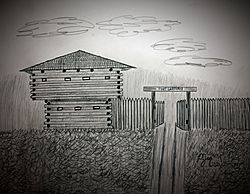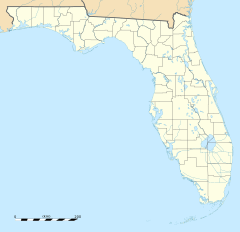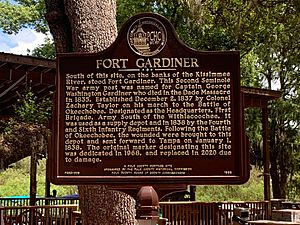Fort Gardiner facts for kids
Quick facts for kids Fort Gardiner |
|
|---|---|
| Historically misspelled as Fort Gardner. | |
| Fort Gardiner was located on the Kissimmee River near the north bank of Kissimmee Lake in present-day Polk County, Florida. in United States | |

Fort Gardiner - Second Seminole War Fort (artist's depiction).
|
|
|
Location of Fort Gardiner
|
|
| Coordinates | 27°54′17″N 81°35′3″W / 27.90472°N 81.58417°W |
| Site information | |
| Condition | Completely destroyed. |
| Site history | |
| Built | 1837 |
| Built by | United States Army |
| In use | 1837-1842 |
| Materials | Pine log stockade and blockhouses. |
| Fate | Abandoned in 1842 and burnt to the ground. |
| Battles/wars | Battle of Lake Okeechobee |
| Events | Fort Gardiner was built as a communications and supply garrison, but after the Battle of Okeechobee it was temporarily utilized as a hospital. |
| Garrison information | |
| Past commanders |
Colonel Zachary Taylor |
| Garrison | Regular army troops and militiamen. |
Fort Gardiner was a military fort built in 1837 by the United States Army. It was made of strong pine logs and had two tall blockhouses for defense. This fort was one of many military outposts built during the Second Seminole War. Its purpose was to help Colonel Zachary Taylor's soldiers capture Seminole Indians and their allies. These groups were resisting being moved from their homes in central Florida Territory to new lands far away, as ordered by the government.
Contents
Building Fort Gardiner
In 1837, Major General Thomas S. Jesup was the commander of all U.S. troops in Florida. He decided that talking would not end the Second Seminole War. So, he ordered Colonel Taylor to find and capture or defeat the enemy.
On December 2, 1837, Colonel Zachary Taylor began building a new fort. Taylor was leading about 1,400 soldiers at the time. The fort was built on the banks of the Kissimmee River. This spot was just south of Lake Tohopekaliga in what is now Polk County, Florida.
The new fort was named Fort Gardiner. It honored Captain George Washington Gardiner. He had been killed on December 28, 1835. This happened during a fight known as Dade's Massacre in present-day Sumter County, Florida.
Taylor's March and Other Forts
On December 19, 1837, Colonel Taylor left Fort Gardiner. He marched south with 1,032 soldiers. This group included volunteers from Missouri, a company called the “Morgan Spies,” and Delaware and Shawnee Indian allies. Most of the soldiers were regular U.S. Army troops.
Taylor's goal was to join General Jesup's plan. They wanted to go deep into Seminole lands. Their aim was to trap the Seminoles and their allies and make them fight or give up.
As they marched, Colonel Taylor ordered another fort to be built. This happened on December 21, 1837. This new fort was named Fort Basinger. It was named after Lieutenant William E. Basinger, who also died during Dade's Massacre. Colonel Taylor left one company of soldiers and about 85 sick men at Fort Basinger.
The Battle of Lake Okeechobee
While Taylor's troops moved south, Seminole leaders were getting ready. About 380 to 480 Seminole Indians and their allies prepared a battleground. Their leaders included Old Sam Jones, Alligator, and Coacoochee.
On December 25, 1837, the Battle of Lake Okeechobee took place. The Seminoles and their allies won a tactical victory. This means they caused more damage to the U.S. forces. The U.S. Army had 26 soldiers killed and 112 wounded. The Seminoles had 11 killed and 14 wounded.
After the battle, the Seminoles and their allies retreated. Colonel Taylor could not chase them because his forces had too many injured soldiers. Taylor gathered his soldiers and marched back to Fort Basinger. From there, they went to Fort Gardiner.
Fort Gardiner as a Hospital
At Fort Gardiner, a temporary hospital was set up. Many wounded soldiers were treated there. Later, many of the injured were taken to Fort Brooke for more care.
While at Fort Gardiner, Colonel Taylor wrote a report. It was sent to Brigadier General Roger Jones in Washington, D.C. The report was called “Seminole Campaign, Official, Report of the Battle of Okeechobee, on the 25th December 1837.” In it, Taylor described his actions before, during, and after the battle. He also praised his soldiers who had died.
The Battle of Lake Okeechobee helped Zachary Taylor's career. It led to his promotion. This battle was likely an important step for him. He later became the 12th President of the United States in 1849.
Fort Gardiner was no longer needed after the Second Seminole War ended in 1842. It was abandoned and most likely burned down.
Who Was George Washington Gardiner?
George Washington Gardiner was born around 1795 in Washington, D.C. He attended the United States Military Academy in West Point, New York. He graduated on March 11, 1812. He became a Third Lieutenant in the 1st Artillery.
Gardiner served in the War of 1812 from 1814 to 1815. He was stationed at Ft. Columbus, New York, and later in Portsmouth, New Hampshire. He was promoted to Second Lieutenant on May 1, 1814.
He returned to West Point as an Adjutant from 1816 to 1817. He also taught infantry tactics. He was promoted to First Lieutenant on April 20, 1818.
Gardiner served at many military posts across the country. These included garrisons in New York, Pennsylvania, Delaware, Georgia, and Florida. He also served in the Cherokee Nation. He was promoted to Brevet Captain in 1828 for ten years of loyal service.
Captain Gardiner was killed during Dade's Massacre on December 28, 1835. He is buried in the St. Augustine National Cemetery in St. Augustine, Florida.
Where is Fort Gardiner Today?
Today, you won't find any parts of Fort Gardiner left. However, its location is marked by a historical sign. This sign was placed by the Florida Board of Parks and Historic Memorials. You can find it at Camp Mack in Lake Wales, Florida.
The sign explains that Fort Gardiner stood south of this spot. It tells how the fort was named for Captain George Washington Gardiner. It also mentions that Colonel Zachary Taylor established it on December 2, 1837. This was during his march to the Battle of Okeechobee.
The sign also notes that the fort was a supply depot. Wounded soldiers were brought here after the Battle of Okeechobee. The original marker was put up in 1968. It was replaced in 2020 after it was damaged.
In August 2020, the marker was moved from the side of Camp Mack Road. It is now closer to the actual fort site, by the Kissimmee River. This marker is part of the Camp Mack Heritage Trail. This trail was created by Camp Mack and the Polk County Historical Commission.




